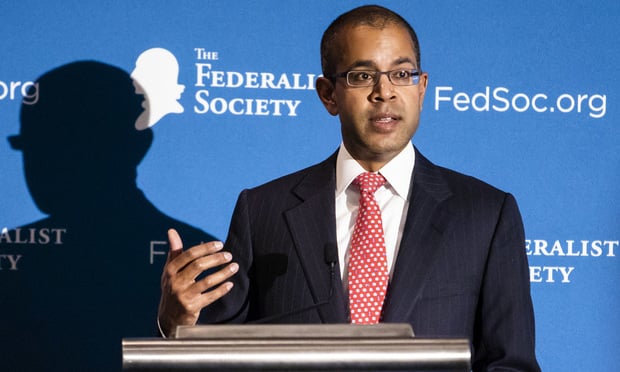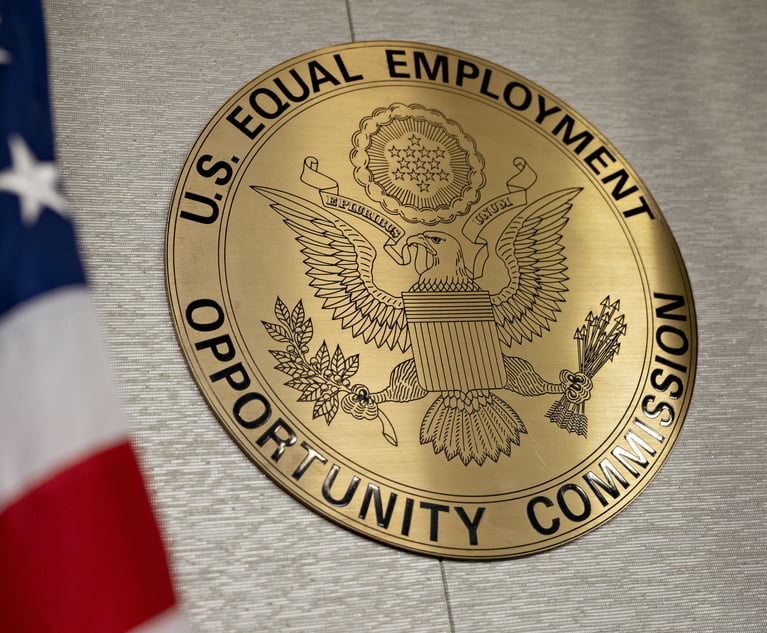Fractured SCOTUS Ruling Keeps CFPB Alive, But Gives More Oversight to President
Justices Elena Kagan, Ruth Bader Ginsburg, Stephen Breyer and Sonia Sotomayor agreed with Chief Justice John Roberts Jr. on the severability question but disagreed that the single-director structure was unconstitutional.
June 29, 2020 at 11:09 AM
7 minute read
 U.S. Supreme Court Chief Justice John G. Roberts Jr. arrives at the U.S. Capitol to be sworn in at the start of the Senate Impeachment trial against President Donald Trump, in Washington, D.C., on Jan. 16, 2020. Credit: Diego M. Radzinschi/ ALM
U.S. Supreme Court Chief Justice John G. Roberts Jr. arrives at the U.S. Capitol to be sworn in at the start of the Senate Impeachment trial against President Donald Trump, in Washington, D.C., on Jan. 16, 2020. Credit: Diego M. Radzinschi/ ALM
The single-director structure of the Consumer Financial Protection Bureau, limiting the president's power to remove the director "at will," violates the Constitution's separation of powers, the U.S. Supreme Court ruled on Monday.
Chief Justice John Roberts Jr., writing for the 5-4 majority, said an agency run by a single director "lacks a foundation in historical practice and clashes with constitutional structure by concentrating power in a unilateral actor insulated from presidential control."
A different majority, led by Roberts, ruled 7-2 that the director's "for cause" removal protection could be severed from the rest of the act creating the bureau. The director now must be removable by the president at will, broad new authority for the White House. Justices Clarence Thomas and Neil Gorsuch dissented from the severability ruling.
"The provisions of the Dodd-Frank Act bearing on the CFPB's structure and duties remain fully operative without the offending tenure restriction," Roberts wrote. "Those provisions are capable of functioning independently, and there is nothing in the text or history of the Dodd-Frank Act that demonstrates Congress would have preferred no CFPB to a CFPB supervised by the president."
Justices Elena Kagan, Ruth Bader Ginsburg, Stephen Breyer and Sonia Sotomayor agreed with Roberts on the severability question but disagreed that the single-director structure was unconstitutional.
"The text of the Constitution allows these common for-cause removal limits," Kagan wrote for the dissenters. "Nothing in it speaks of removal. And it grants Congress authority to organize all the institutions of American governance, provided only that those arrangements allow the President to perform his own constitutionally assigned duties."
In the case Seila Law v. CFPB, which came from the U.S. Court of Appeals for the Ninth Circuit, the justices were asked if the restriction on removing the bureau's director only "for cause" violated the separation of powers because it limited the power of the president to direct the executive branch, and if it were unconstitutional, could the removal provision be severed or must the entire law fall.
The CFPB has been a target of business criticism and legal challenges almost from its creation as part of the Dodd-Frank Wall Street Reform and Consumer Protection Act in 2010. The bureau can issue rules, conduct investigations and administrative enforcement proceedings and bring enforcement actions in federal court.
The outcome of the challenge was watched closely not only for the fate of the consumer agency, but because of its potential significance for the future of the large number of independent agencies created by Congress. Numerous business advocacy groups filed friend of the court briefs backing Seila Law.
A single director appointed by the president and confirmed by the Senate heads the bureau and serves for a five-year term. The president, until Monday, could remove the director only "for cause"—for example, "inefficiency, neglect of duty or malfeasance in office." President Donald Trump named Kathy Kraninger to lead the agency; she succeeded Richard Cordray, the Obama-era consumer bureau director.
The case at the Supreme Court stemmed from an investigation by the CFPB into Seila Law, a law firm in California that provides debt relief services, among other services. The bureau issued an investigative demand in 2017 for responses to interrogatories and document requests but the law firm refused to comply.
After the CFPB sued Seila Law to enforce its demands, a federal district court ordered the law firm to comply. Seila Law appealed, arguing that the bureau lacked authority to issue its demand requests because the bureau's structure violated the Constitution's separation of powers. The constitutional problem, the law firm contended, was the for-cause removal restriction on the president, which encroached on his authority to direct executive branch operations.
The Ninth Circuit rejected Seila Law's arguments. The D.C. Circuit in an earlier opinion involving a different company, also upheld the bureau's constitutionality. In that case, PHH Corp. v. CFPB, Justice Brett Kavanaugh, then a judge on the appeals court, lambasted the "massive" and "unchecked" power of the agency's director.
During arguments in the Supreme Court in March, the justices appeared divided as they focused most of their questions on the actual meaning of "for cause" removal and whether it was a weak or strong restraint on a president; whether multihead agencies posed a lesser threat to a president's authority than a single director, and if Congress could extend for-cause removal to cabinet officials.
 Kannon Shanmugam of Paul Weiss speaks last year at a Federalist Society event in Washington, D.C. Photo: Diego M. Radzinschi/ALM
Kannon Shanmugam of Paul Weiss speaks last year at a Federalist Society event in Washington, D.C. Photo: Diego M. Radzinschi/ALMThe arguments featured a trio of former clerks to the late Justice Antonin Scalia: Kannon Shanmugam of Paul, Weiss, Rifkind, Wharton & Garrison; Paul Clement of Kirkland & Ellis; and Noel Francisco, the U.S. solicitor general. Clement was appointed to defend the bureau after the Trump Justice Department sided with Seila Law's challenge.
Ginsburg and Sotomayor questioned the claim by Seila Law's counsel, Shanmugam, that the CFPB's independent structure was "unprecedented and unconstitutional."
Sotomayor said the Social Security Administration had a single head and was "more powerful" than the CFPB. "I don't think that this is so unprecedented as you claim." And Ginsburg said the "for cause" removal was "a very modest restraint which stops a president from removing someone at whim for someone who is loyal to the president instead of the consumers that Congress intended."
But Kavanaugh told Clement, who was defending the removal restriction, "If you win, it's really the next president that faces the issue. The president may have a different concept of consumer protection and can do nothing about it."
Francisco, who agreed with Shanmugam that the for-cause removal provision violates the separation of powers, urged the justices—in disagreement with Shanmugam—to rule that the provision could be severed from the rest of the act creating the CFPB. He urged them not to extend their ruling in 1935 upholding that type of removal for multihead agencies to single-head agencies because that would be a "revolution" that could lead to for-cause removal of cabinet officials.
Read more:
Justices Fret About Sweep of Any Ruling Against Consumer Protection Bureau
How Paul Clement Is Defending Obama's Consumer Protection Bureau
SCOTUS Will Hear Major Challenge to Independence of Consumer Bureau
Paul Weiss Pokes Gibson Dunn in New SCOTUS Brief in Consumer Bureau Case
CFPB, Changing Stance, Backs Law Firm Fighting Agency's Independent Design
D.C. Circuit's Brett Kavanaugh Doubles Down on Criticism of CFPB
NOT FOR REPRINT
© 2025 ALM Global, LLC, All Rights Reserved. Request academic re-use from www.copyright.com. All other uses, submit a request to [email protected]. For more information visit Asset & Logo Licensing.
You Might Like
View All
Trump Administration Faces Legal Challenge Over EO Impacting Federal Workers
3 minute read
US Judge Cannon Blocks DOJ From Releasing Final Report in Trump Documents Probe
3 minute read
Private Equity Giant KKR Refiles SDNY Countersuit in DOJ Premerger Filing Row
3 minute readLaw Firms Mentioned
Trending Stories
- 15th Circuit Considers Challenge to Louisiana's Ten Commandments Law
- 2Crocs Accused of Padding Revenue With Channel-Stuffing HEYDUDE Shoes
- 3E-discovery Practitioners Are Racing to Adapt to Social Media’s Evolving Landscape
- 4The Law Firm Disrupted: For Office Policies, Big Law Has Its Ear to the Market, Not to Trump
- 5FTC Finalizes Child Online Privacy Rule Updates, But Ferguson Eyes Further Changes
Who Got The Work
J. Brugh Lower of Gibbons has entered an appearance for industrial equipment supplier Devco Corporation in a pending trademark infringement lawsuit. The suit, accusing the defendant of selling knock-off Graco products, was filed Dec. 18 in New Jersey District Court by Rivkin Radler on behalf of Graco Inc. and Graco Minnesota. The case, assigned to U.S. District Judge Zahid N. Quraishi, is 3:24-cv-11294, Graco Inc. et al v. Devco Corporation.
Who Got The Work
Rebecca Maller-Stein and Kent A. Yalowitz of Arnold & Porter Kaye Scholer have entered their appearances for Hanaco Venture Capital and its executives, Lior Prosor and David Frankel, in a pending securities lawsuit. The action, filed on Dec. 24 in New York Southern District Court by Zell, Aron & Co. on behalf of Goldeneye Advisors, accuses the defendants of negligently and fraudulently managing the plaintiff's $1 million investment. The case, assigned to U.S. District Judge Vernon S. Broderick, is 1:24-cv-09918, Goldeneye Advisors, LLC v. Hanaco Venture Capital, Ltd. et al.
Who Got The Work
Attorneys from A&O Shearman has stepped in as defense counsel for Toronto-Dominion Bank and other defendants in a pending securities class action. The suit, filed Dec. 11 in New York Southern District Court by Bleichmar Fonti & Auld, accuses the defendants of concealing the bank's 'pervasive' deficiencies in regards to its compliance with the Bank Secrecy Act and the quality of its anti-money laundering controls. The case, assigned to U.S. District Judge Arun Subramanian, is 1:24-cv-09445, Gonzalez v. The Toronto-Dominion Bank et al.
Who Got The Work
Crown Castle International, a Pennsylvania company providing shared communications infrastructure, has turned to Luke D. Wolf of Gordon Rees Scully Mansukhani to fend off a pending breach-of-contract lawsuit. The court action, filed Nov. 25 in Michigan Eastern District Court by Hooper Hathaway PC on behalf of The Town Residences LLC, accuses Crown Castle of failing to transfer approximately $30,000 in utility payments from T-Mobile in breach of a roof-top lease and assignment agreement. The case, assigned to U.S. District Judge Susan K. Declercq, is 2:24-cv-13131, The Town Residences LLC v. T-Mobile US, Inc. et al.
Who Got The Work
Wilfred P. Coronato and Daniel M. Schwartz of McCarter & English have stepped in as defense counsel to Electrolux Home Products Inc. in a pending product liability lawsuit. The court action, filed Nov. 26 in New York Eastern District Court by Poulos Lopiccolo PC and Nagel Rice LLP on behalf of David Stern, alleges that the defendant's refrigerators’ drawers and shelving repeatedly break and fall apart within months after purchase. The case, assigned to U.S. District Judge Joan M. Azrack, is 2:24-cv-08204, Stern v. Electrolux Home Products, Inc.
Featured Firms
Law Offices of Gary Martin Hays & Associates, P.C.
(470) 294-1674
Law Offices of Mark E. Salomone
(857) 444-6468
Smith & Hassler
(713) 739-1250











